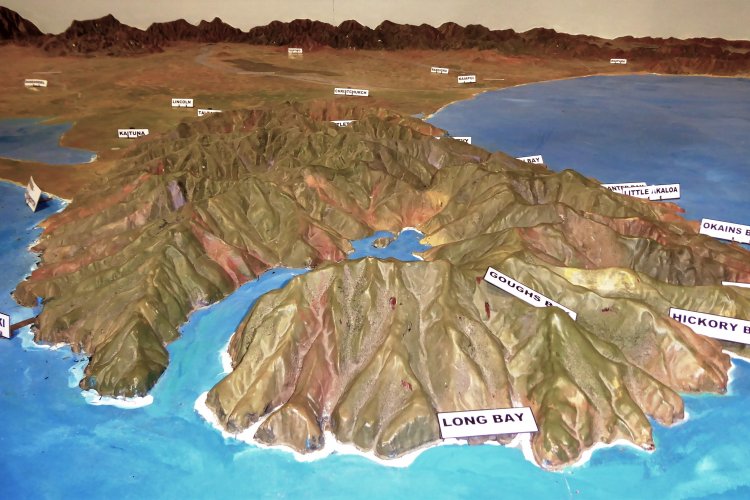Our collections
Featured items from our collections
 Small waka tiwai. This is one of three small waka carved by Murray Thacker in 1983. Murray used the knowledge gained carving these waka to great effect when he undertook extensive work in the 1990s on the construction of the Ngāi Tahu waka, Kōtukumairangi.
Small waka tiwai. This is one of three small waka carved by Murray Thacker in 1983. Murray used the knowledge gained carving these waka to great effect when he undertook extensive work in the 1990s on the construction of the Ngāi Tahu waka, Kōtukumairangi. Hand painted bass drum, c.1920s. Painted bass drum heads like this one became hugely popular in the 1920s and 1930s. Lake and mountain scenes were a favourite theme. The landscape depicted on this drum is most likely an interpretation of New Zealand's Piopiotahi (Milford Sound).
Hand painted bass drum, c.1920s. Painted bass drum heads like this one became hugely popular in the 1920s and 1930s. Lake and mountain scenes were a favourite theme. The landscape depicted on this drum is most likely an interpretation of New Zealand's Piopiotahi (Milford Sound). Hand carved embellished gourd, Theo Schoon, c.1960. Schoon was an artist, photographer and carver of Dutch descent. He was very interested in Māori art and began to grow and carve his own gourds in 1956–57. Most of his gourds were sold to tourists and only a few remain in New Zealand today.
Hand carved embellished gourd, Theo Schoon, c.1960. Schoon was an artist, photographer and carver of Dutch descent. He was very interested in Māori art and began to grow and carve his own gourds in 1956–57. Most of his gourds were sold to tourists and only a few remain in New Zealand today. Canterbury relief map, 1940. This large relief map of Canterbury was created for the New Zealand Centennial Exhibition held at Rongotai, Wellington in 1940. It was restored on site at the museum in 1993.
Canterbury relief map, 1940. This large relief map of Canterbury was created for the New Zealand Centennial Exhibition held at Rongotai, Wellington in 1940. It was restored on site at the museum in 1993. Scrimshaw bullock horn powder flask. Scrimshaw is the art of etching patterns into bone or ivory. It was a common pastime among sailors and whalers.
Scrimshaw bullock horn powder flask. Scrimshaw is the art of etching patterns into bone or ivory. It was a common pastime among sailors and whalers. This rare three tiered thread caddy made from whalebone was used to hold spools of thread for tapestry work. It was collected through John Doleman of Christchurch in the 1950s.
This rare three tiered thread caddy made from whalebone was used to hold spools of thread for tapestry work. It was collected through John Doleman of Christchurch in the 1950s. Waka huia, Taranaki style. This wakahuia was collected in 1959. It is carved in the Taranaki style and features spiralled figures intertwining with paua shell eyes. The box is very old while the lid is of more recent design.
Waka huia, Taranaki style. This wakahuia was collected in 1959. It is carved in the Taranaki style and features spiralled figures intertwining with paua shell eyes. The box is very old while the lid is of more recent design. This magnificent block of pounamu (greenstone) from the Arahura region of the West Coast was in the process of being cut into adze blades. It was found by Thomas Ware at Pā Bay near Okains on Banks Peninsula in c.1888. It was presented to the museum by H.J. Bond Ware and his son John in 2005.
This magnificent block of pounamu (greenstone) from the Arahura region of the West Coast was in the process of being cut into adze blades. It was found by Thomas Ware at Pā Bay near Okains on Banks Peninsula in c.1888. It was presented to the museum by H.J. Bond Ware and his son John in 2005. Tāniko waistcoat. This rare waistcoat incorporates traditional tāniko weaving into a garment of European design. It was gifted to the teacher at a small school in rural Taranaki upon his retirement.
Tāniko waistcoat. This rare waistcoat incorporates traditional tāniko weaving into a garment of European design. It was gifted to the teacher at a small school in rural Taranaki upon his retirement. Hei tiki (pendant in human form), collected 27 June 1959. Originally part of the collection of K.A. Webster. It has one wax eye and one original paua shell eye. It also has an old cord and toggle still attached.
Hei tiki (pendant in human form), collected 27 June 1959. Originally part of the collection of K.A. Webster. It has one wax eye and one original paua shell eye. It also has an old cord and toggle still attached. Male Huia beak brooch, c.1900. This gold mounted brooch is made from the beak of a male huia, a bird native to New Zealand that became extinct in 1907.
Male Huia beak brooch, c.1900. This gold mounted brooch is made from the beak of a male huia, a bird native to New Zealand that became extinct in 1907.
